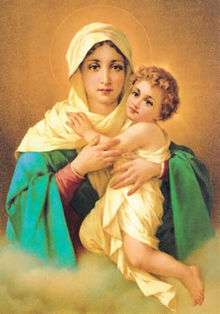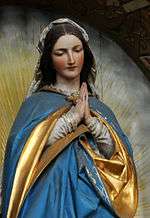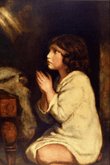Litany of the Blessed Virgin Mary

The Litany of the Blessed Virgin Mary is a Marian litany originally approved in 1587 by Pope Sixtus V. It is also known as the Litany of Loreto, for its first-known place of origin, the Shrine of Our Lady of Loreto (Italy), where its usage was recorded as early as 1558.
The litany contains many of the titles used formally and informally for the Virgin Mary, and would often be recited as a call and response chant in a group setting. This litany is called Litaniae lauretanae in Latin. Many classical composers, like Wolfgang Amadeus Mozart have written Litaniae lauretanae.
Background
According to Directory on Popular Piety:
Litanies are to be found among the prayers to the Blessed Virgin recommended by the Magisterium. These consist in a long series of invocations of Our Lady, which follow in a uniform rhythm, thereby creating a stream of prayer characterized by insistent praise and supplication. The invocations, generally very short, have two parts: the first of praise (Virgo clemens), the other of supplication (Ora pro nobis). The liturgical books contain two Marian litanies: The Litany of Loreto, repeatedly recommended by the Roman Pontiffs; and the Litany for the Coronation of Images of the Blessed Virgin Mary, which can be an appropriate substitute for the other litany on certain occasions. ...The Litanies are independent acts of worship. They are important acts of homage to the Blessed Virgin Mary, or as processional elements, or form part of a celebration of the Word of God or of other acts of worship.[1]
Form
In form, the Litany of Loreto is composed on a fixed plan common to several Marian litanies already in existence during the second half of the 15th century, which in turn are connected with a notable series of Marian litanies that began to appear in the twelfth century and became numerous in the 13th and 14th. The Loreto text had, however, the good fortune to be adopted in the famous shrine, and in this way to become known, more than any other, to the many pilgrims who flocked there during the 16th century. The text was brought home to the various countries of Christendom, and finally it received ecclesiastical sanction.[2]
Twelve invocations refer to Mary as Mother; six extoll her as Virgin. Thirteen titles are derived from the Old Testament, followed by four calling on her as helper and advocate. The last thirteen name Mary as Queen.
History
Origins
| A series of articles on |
| Mother of Jesus |
| Chronology |
|---|
|
|
| Marian perspectives |
|
|
| Catholic Mariology |
|
|
| Marian dogmas |
|
|
| Mary in culture |
|
|
There is a great lack of documentary evidence concerning the origin of the Litany of Loreto, the growth and development of the litany into the forms under which it is known, and as it was for the first time definitely approved by the Catholic Church in the year 1587. Some writers declare that they know nothing of its origin and history; others, on the contrary, trace it back to the translation of the Holy House (1294); others, to Pope Sergius I (687); others, again, to Gregory the Great or to the 5th century; while others go as far back as the earliest ages of the Church, and even Apostolic times. Historical criticism posits it to have been composed during the early years of the 16th century or the closing years of the 15th.[2] Before that time, there were litanies of Mary - one in Gaelic, probably of the eighth century, and others of later date, in which the invocations were much longer than those in the Litany of Loreto.[3]
The most ancient printed copy hitherto discovered is that of Dillingen in Germany, dating from 1558; it is fairly certain that this is a copy of an earlier, but thus far, the oldest known Italian copy dates from 1576.[2]
The litany was probably published and circulated in Germany by Saint Petrus Canisius. The Dillingen copy is entitled: Letania Loretana. Ordnung der Letaney von unser lieben Frawen wie sie zu Loreto alle Samstag gehalten ("Order of the Litany of Our Lady as said every Saturday at Loreto"). The text is just the same as we have it today, except that it has Mater piissima and Mater mirabilis, where we have Mater purissima and Mater admirabilis. Further, the invocations Mater creatoris and Mater salvatoris are wanting, though this must be due to some oversight of the editor, since they are found in every manuscript of this group; on the other hand, the Auxilium christianorum is introduced though it does not occur in the other texts. This title is found in a Litany of Loreto printed in 1558. Pope Pius V could not have introduced the invocation "Auxilium christianorum in 1571 after the Battle of Lepanto, as stated in the sixth lesson of the Roman Breviary for the feast of S. Maria Auxiliatrix (24 May); and to this conclusion the Dillingen text adds indisputable evidence.
Development
Pope Pius V by Motu Proprio of 20 March 1571, published 5 April, had prohibited all existing offices of the Virgin Mary, disapproving in general all the prayers therein, and substituting a new Officium B. Virginis without those prayers and consequently without any litany. It would seem that this action on the part of the pope led the clergy of Loreto to fear that the text of their litany was likewise prohibited. At all events, in order to keep up the old time custom of singing the litany every Saturday in honor of the Blessed Virgin, a new text was drawn up containing praises drawn directly from the Scriptures, and usually applied to the Bl. Virgin in the Liturgy of the Church. This new litany was set to music by the choirmaster of the Basilica of Loreto, Costanzo Porta, and printed at Venice in 1575. It is the earliest setting to music of a Marian litany that we know of. In the following year (1576) these Scriptural litanies were printed for the use of pilgrims.
On 5 February 1578, the archdeacon of Loreto, Giulio Candiotti, sent to Pope Gregory XIII the "New praises or litanies of the most holy Virgin, drawn from Sacred Scripture", with Porta's music, expressing the wish that His Holiness would cause it to be sung in St. Peter's and in other churches as was the custom at Loreto. The pope's reply is not known, but we have the opinion of the theologian to whom the matter was referred, in which the composition of the new litany is praised, but which does not judge it opportune to introduce it into Rome or into church use on the authority of the pope, all the more because Pius V "in reforming the Little Office of the Blessed Virgin completely abolished, among other things, some similar litanies of the Blessed Virgin which existed in the old office. The judgment concluded that the litany might be sung at Loreto as a devotion proper to this shrine, and if others wanted to adopt it they might do so by way of private devotion.
This attempt having failed, the Scriptural litany straightway began to lose favor, and the Loreto text was once more resumed. In another manual for pilgrims, published that same year 1578, the Scriptural litany is omitted, and the old Loreto text appears. The Loreto text was introduced elsewhere, and even reached Rome, when Pope Sixtus V, who had entertained a singular devotion for Loreto, by the Bull "Reddituri" of 11 July 1587, gave formal approval to it, as to the Litany of the Holy Name of Jesus, and recommended preachers everywhere to propagate its use among the faithful.
On the strength of this impulse given to the Litany of Loreto, certain ascetical writers began to publish a great number of litanies in honour of the Saviour, the B. Virgin, and the saints, often ill-advised and containing expressions theologically incorrect, so that Pope Clement VIII had promulgated (6 Sept., 1601) a severe decree of the Holy Office, which, while upholding the litanies contained in the liturgical books as well as the Litany of Loreto, prohibited the publication of new litanies, or use of those already published in public worship, without the approbation of the Congregation of Rites.
| Part of a series on the |
| Mariology of the Catholic Church |
|---|
 Virgo by Josef Moroder-Lusenberg |
|
|
|
|
|
At Rome the Litany of Loreto was introduced into the Basilica di Santa Maria Maggiore by Cardinal Francesco Toledo in 1597; and in 1613, Pope Paul V ordered it to be sung in that church, morning and evening, on Saturdays and on vigils and feasts of the Madonna. As a result of this example the Loreto Litany began to be used, and is still largely used, in all the churches of Rome. The Dominicans, at their general chapter held at Bologna in 1615, ordered it to be recited in all the convents of their order after the Office on Saturdays at the end of the customary "Salve Regina". The Litany of Loreto was first included in the Rituale Romanum in 1874, as an appendix.[1]
Additions
- The Dominicans caused the invocation "Regina sacratissimi rosarii" (Queen of the Most Holy Rosary) to be inserted in the litany, and it appears in print for the first time in a Dominican Breviary dated 1614, as has been pointed out by Father Walsh, O.P., in "The Tablet", 24 Oct., 1908. Although by decree of 1631, and by Bull of Pope Alexander VII (1664), it was strictly forbidden to make any additions to the litanies, another decree of the Congregation of Rites, dated 1675, permitted the Confraternity of the Rosary to add the invocation "Regina sacratissimi rosarii", and this was prescribed for the whole Church by Pope Leo XIII on 24 December 1883.[3]
- The invocation "Queen of All Saints" was added by Pope Pius VII when he returned to Rome after his long imprisonment by order of Napoleon.[3]
- The title "Queen Conceived without Original Sin" dates from 1846, although the solemn definition of the dogma of the Immaculate Conception was not made until eight years later.
- By decree of 22 April 1903, the Leo XIII added the invocation "Mater boni consilii" (Mother of Good Counsel0, which, under the form of "Mater veri consilii", was contained in the Marian litany used for centuries in St Mark's Basilica, Venice.
- In 1766 Clement XIII granted Spain the privilege of adding after "Mater intemerata" the invocation "Mater immaculata", which is still customary in Spain, notwithstanding the addition of "Regina sine labe originali concepta". This last invocation was originally granted by Pope Pius IX to the Bishop of Mechlin in 1846, and, after the definition of the Immaculate Conception (1854), the Congregation by various rescripts authorized many dioceses to make a like addition, so that in a short time it became the universal practice.
- The latest addition, "Queen of Peace, pray for us," was ordered by Benedict XV in 1917.
- In 1950, Pope Pius XII added "Queen assumed into Heaven".
- In 1980, Pope John Paul II added "Mother of the Church". The invocation "Queen of Families" was added on December 31, 1995, also by Pope John Paul II.
A partial indulgence is granted to those who recite this Litany.[4]
The Litany of the Blessed Virgin Mary has also been set to music (as the Litaniae lauretanae)[3] by composers such as Palestrina, Charpentier, Mozart,[5] Jan Dismas Zelenka,[6] Joseph Auer,[7] and Johannes Habert.[8]
See also
References
- 1 2 Congregation for Divine Worship and the Discipline of the Sacraments. Directory on Popular Piety, §203, December 2001
- 1 2 3 Santi, Angelo de. "Litany of Loreto." The Catholic Encyclopedia Vol. 9. New York: Robert Appleton Company, 1910. 10 December 2017
- 1 2 3 4 Sullivan, John F., The Externals of the Catholic Church, P.J. Kenedy & Sons (1918) pp. 273-79

- ↑ Joseph Cardinal Ferretto, Sacred Apostolic Penitentiary, The Enchiridion of Indulgences, No. 29, Liberia Editrice Vatican, 1968
- ↑ Abert, Hermann. W. A. Mozart, Yale University Press, 2007, p. 225, ISBN 9780300072235
- ↑ Stockigt, Janice B., Jan Dismas Zelenka: A Bohemian Musician at the Court of Dresden, Oxford University Press, 2000, p. 179, ISBN 9780198166221
- ↑ Auer, Joseph, "Lauretanische Litanei" (1890). Marian Sheet Music. 37
- ↑ Habert, Johannes, "Lauretanische Litanei in A dur, No. 2" (1877). Marian Sheet Music. 65
![]()
External links
| Wikisource has original text related to this article: |
